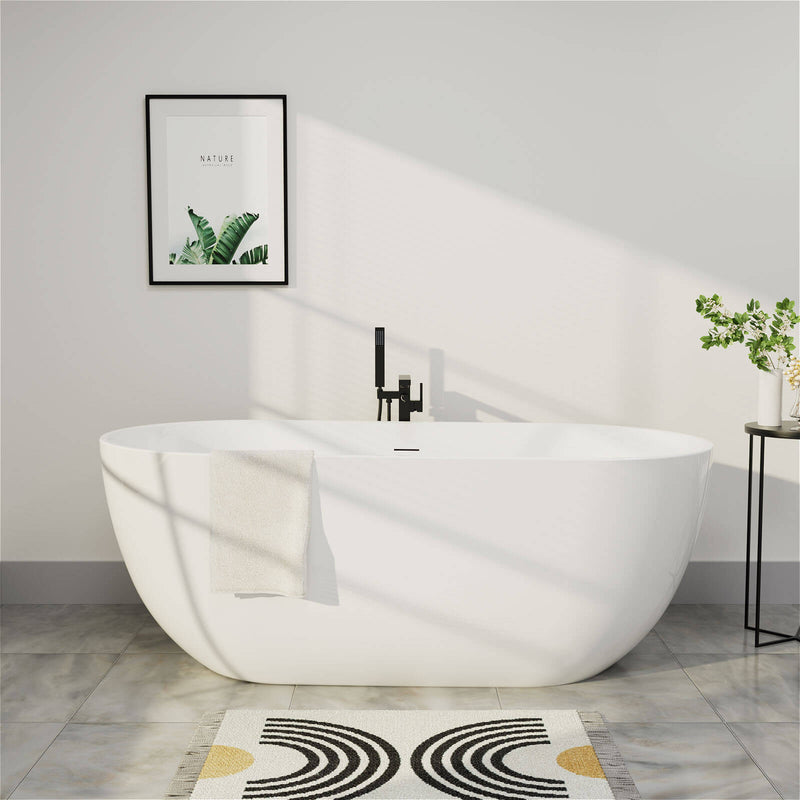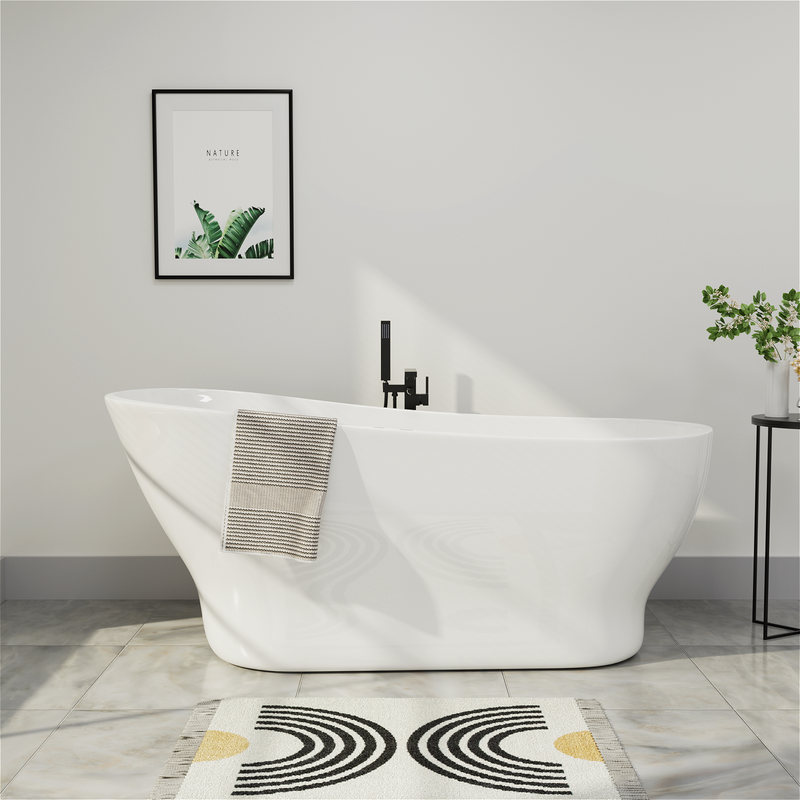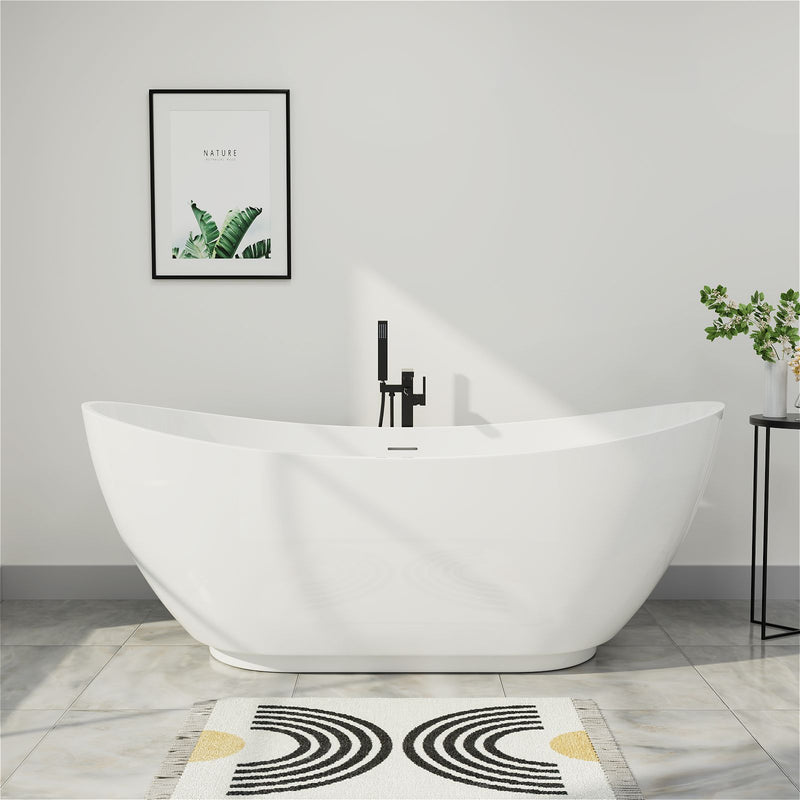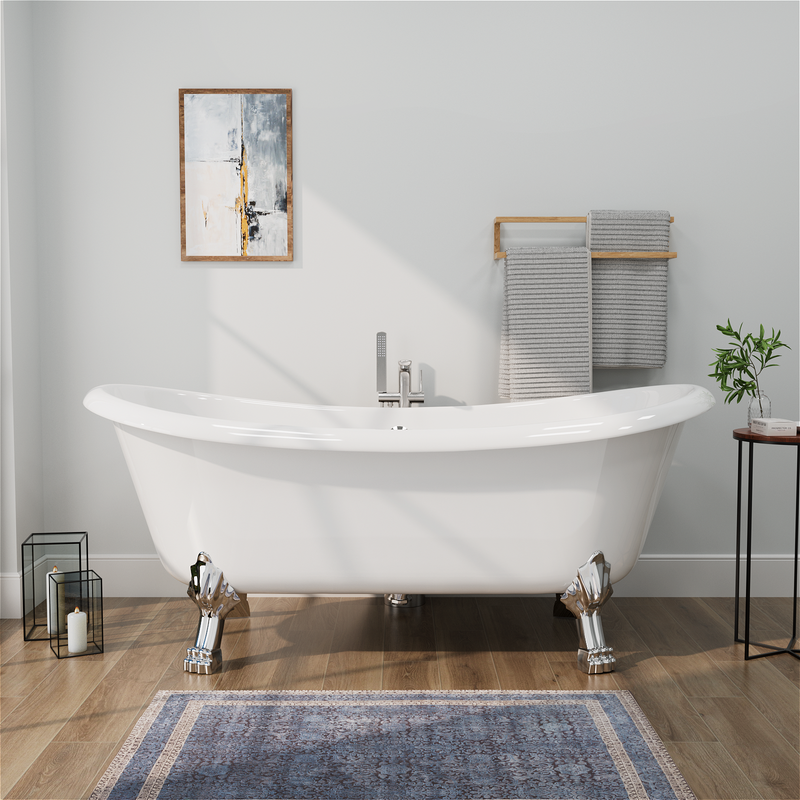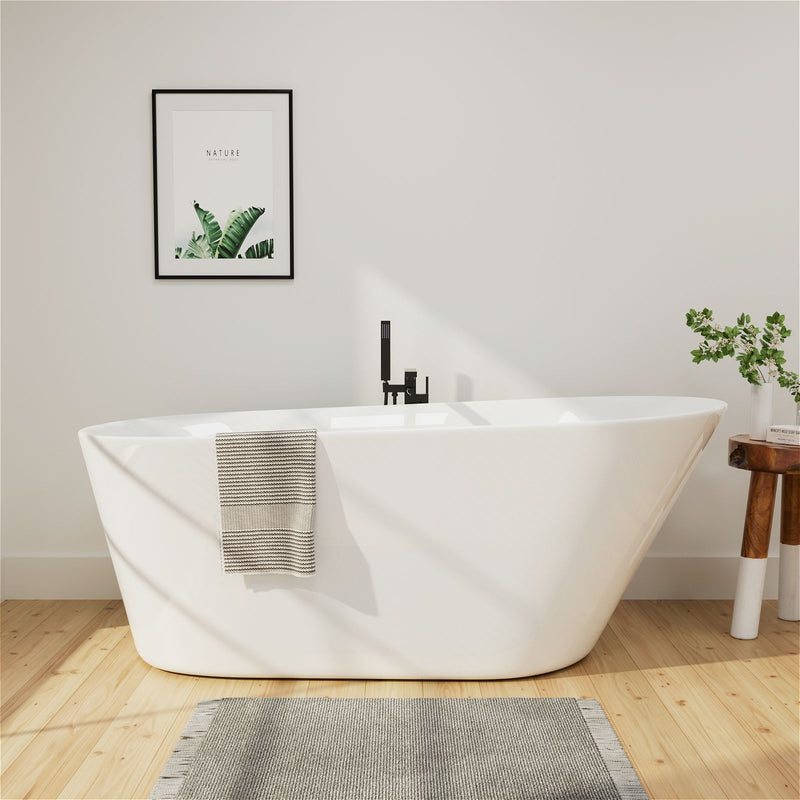When you're searching for the right bathtub, you'll find that there are two main types to choose from: alcove and freestanding. Since bathtubs can last for decades, choosing the right one for your home is essential. It's important to understand the difference between these two types of bathtubs and how they can fit your preferences and the unique needs of your home. To help you make your choice, we've compiled some information about both types of bathtubs to help you when choosing a bathtub type.
What is an Alcove Bathtub?
An alcove bathtub does not refer to a specific type of bathtub, but rather to the way it is installed. This refers to the bathtub being installed in a recessed position in the bathroom, meaning they are usually installed on three connected walls or in an alcove in the bathroom. Some modern designs only feature two walls or a large window to eliminate the limitations of this installation. Since this installation leaves an open space and does not provide enough privacy, a shower curtain or sliding door is often added.

What is a Freestanding Bathtub?
A freestanding bathtub is a type of bathtub that can be placed anywhere without relying on wall support. This type of bathtub often has a stronger sense of design and artistry, and can become the visual focus of the bathroom. According to the different shapes and support methods, freestanding bathtubs are mainly divided into the following types:
The claw-foot bathtub is the most classic freestanding bathtub, with decorative feet at the bottom, usually made of cast iron, exuding a strong retro charm. This type of bathtub was extremely popular in the Victorian era and is still the first choice for traditional style bathrooms today.
Modern freestanding bathtubs are designed with simple and smooth lines, and the materials are mostly acrylic or composite materials. The shapes include oval, round, rectangular and other variations. This type of bathtub is suitable for modern minimalist, Nordic or industrial style bathroom spaces.
Tub-style bathtubs are inspired by traditional wooden barrels, usually made of wood or imitation wood, with a large depth and can provide an immersive bathing experience. This type of bathtub is particularly suitable for creating a Japanese hot spring or natural style bathroom environment.
Installation Method and Construction Requirements
How to Install an Alcove Bathtub
The installation of an alcove bathtub is a relatively complicated process, which needs to be planned in the early stages of bathroom decoration. First, the dimensions of the installation location must be accurately measured, including length, width and height, and whether the wall is straight. The three sides of the bathtub that touch the wall need to be specially waterproofed, usually with waterproof paint and waterproof panels installed to prevent water seepage after long-term use.

The layout of the piping system is particularly critical, and the location of the drain and inlet must perfectly match the design of the bathtub. Most alcove bathtubs use a front-end drainage design, and the drain pipe needs to pass through the floor to connect to the main drainage system. The water inlet pipe is usually led out from the wall, and the mixing valve and faucet need to be installed at the appropriate height in advance.
During the installation process, the joints between the edge of the bathtub and the wall need to be sealed with high-quality mildew-proof silicone, which directly affects the later use experience and maintenance difficulty. Professional installation teams will also use a level to ensure that the bathtub is completely level to avoid water accumulation. After the installation is completed, it is usually necessary to install a shower curtain rod or glass partition on the open side of the bathtub to achieve dry and wet separation.
How to Install a Freestanding Bathtub
The installation of a freestanding bathtub seems simple, but there are actually many details that need to be paid attention to. The first thing to consider is the load-bearing capacity of the ground, especially for bathtubs made of heavy materials such as cast iron, the floor structure may need to be reinforced. The placement of the bathtub needs to reserve enough space for movement, and it is generally recommended to keep at least 60 cm of passage area around it.
The drainage system design of a free-standing bathtub is relatively special. There are two common ways: one is the traditional floor drainage, where the drain pipe passes through the floor; the other is the concealed drainage, where the pipe is buried under the floor, with only the exquisite drain outlet exposed. There are also many options for the water inlet system, including floor-standing faucets, wall-mounted faucets, and even ceiling-mounted faucets, all of which need to be positioned before installation.
For styles with legs such as claw-foot bathtubs, it is necessary to ensure that each leg is firmly in contact with the ground, and use adjustment bolts to balance if necessary. For free-standing bathtubs without legs, special attention should be paid to the complete fit between the bottom and the floor to avoid cracking caused by uneven force. Regardless of the type, full testing should be carried out after installation to check whether the drainage is smooth and whether there is any leakage.
Comprehensive Comparison of Installation Difficulty
From the perspective of construction complexity, alcove bathtubs usually require more preliminary preparation work, including wall modification, waterproof layer construction and precise pipe pre-embedding. These works are best completed at one time when the bathroom is renovated as a whole, and the cost of later modification is high. The installation of freestanding bathtubs is relatively flexible and can be added even after the decoration is completed, but there are specific requirements for space size and ground conditions.
In terms of installation time, alcove bathtubs usually take 2-3 days to complete all processes, including the drying time of the waterproof layer; the installation of freestanding bathtubs may be completed within 1 day, but the premise is that all infrastructure is ready. From the perspective of professional requirements, the installation of alcove bathtubs is best left to experienced professional teams, while some simple freestanding bathtubs can be installed by owners with strong hands-on ability.
Space Utilization and Layout Analysis
Spatial Adaptability of Alcove Bathtubs
Alcove bathtubs have obvious advantages in space utilization, especially suitable for bathrooms with limited area. A standard 60-inch long alcove bathtub only needs about 1.5 square meters of dedicated space to provide complete bathing functions. This bathtub cleverly uses the support of three walls to avoid extra space waste, and is the most cost-effective choice for small bathrooms.

In terms of layout, alcove bathtubs are usually installed along the long side of the bathroom, forming a straight line with the toilet and sink. This layout is smooth and compact, and the dynamic line is reasonable. For square bathrooms, corner bathtubs can make full use of the corner space that is difficult to use and release more activity areas. The overall bathroom design common in modern homes also often uses the combination of alcove bathtubs and shower areas to maximize functionality.
Another spatial advantage of alcove bathtubs is that they can easily separate dry and wet areas. Simply install a shower curtain or glass partition on the open side to effectively control the splash of water and keep other areas of the bathroom dry. This design is particularly suitable for small bathrooms without independent shower rooms. It not only meets a variety of bathing needs, but also does not make the space appear crowded.
Space Requirements for Freestanding Bathtubs
Freestanding bathtubs have relatively high space requirements. Not only do you need to consider the size of the bathtub itself, but you also need to reserve enough surrounding activity areas. Generally speaking, a freestanding bathtub needs to occupy a much larger space than its actual size, and at least 60 cm of clearance is required around it to ensure comfort and safety. Therefore, this type of bathtub is more suitable for spacious bathrooms with an area of more than 8 square meters.
From the perspective of layout, a freestanding bathtub is usually placed in the center as the core element of the bathroom, forming a symmetrical or focal spatial composition. In a large master bathroom, a freestanding bathtub can be placed near the window to enjoy natural light and scenery; it can also be set in the center of the bathroom to create a luxurious hotel-like atmosphere. For irregular bathroom spaces, the flexible placement of a freestanding bathtub can resolve the layout difficulties caused by the building structure.
It is worth noting that although the freestanding bathtub is beautiful, it has certain limitations in terms of dry and wet separation. Unless a separate shower room is installed, the water splashes easily to the surrounding area when the freestanding bathtub is used alone. This is why many families who choose a freestanding bathtub will also retain a separate shower space, further increasing the requirements for the bathroom area.
Comprehensive Evaluation of Space Efficiency
From a pure space utilization perspective, the alcove bathtub is undoubtedly a more efficient choice. It can compress the bathing function into the smallest space, which is particularly suitable for space-constrained environments such as apartments and small-sized houses. Data shows that, under the premise of providing the same comfortable bathing experience, the alcove bathtub saves about 35% of space on average compared to the freestanding type.
However, the freestanding bathtub has irreplaceable value in improving the quality of space. It can sublimate the simple bathing function into a spatial art, creating a relaxing and luxurious atmosphere. For residences with ample area, the freestanding bathtub will not only not waste space, but can also improve the grade and comfort of the overall bathroom space. In high-end residences such as villas and luxury houses, freestanding bathtubs are almost standard configurations.
Comparison of Design Style and Aesthetics
Style Expression of Alcove Bathtubs
The alcove bathtub is relatively restrained in style expression, and mainly presents different design languages through materials and surrounding decorations. The most common acrylic alcove bathtub has simple lines and is suitable for modern minimalist style bathrooms. By matching different wall tiles and shower curtains, you can easily create a variety of effects from industrial style to Nordic style.
For owners who pursue individuality, the alcove bathtub can also achieve unique effects through creative design. For example, mosaic tiles can be used to decorate the bathtub perimeter to create a Mediterranean feel, or natural stone countertops can be used to enhance the overall texture. Platform alcove bathtubs can switch freely between modern and traditional styles through the choice of countertop materials.
Although the alcove bathtub itself is relatively simple in shape, it can also create a stunning design effect by coordinating with other elements in the bathroom. The key lies in the unity of the overall style and the grasp of details, such as the careful selection of faucet styles, tile textures, lighting design and other elements.
Aesthetic Advantages of Freestanding Bathtubs
Freestanding bathtubs have a natural advantage in design aesthetics and are themselves a fine piece of bathroom art. The classic-style claw-foot bathtub is made of cast iron, the surface is treated with high-temperature enamel, and is equipped with gorgeous gold-plated faucets, which can instantly enhance the retro style of the bathroom. This type of bathtub is an ideal choice for Victorian and French classical style bathrooms.

Modern-style freestanding bathtubs show contemporary design aesthetics through smooth curves and minimalist shapes. High-grade acrylic materials can shape various organic forms, while copper bathtubs exude a low-key metallic luster. These independent bathtubs with strong design sense often become the visual focus of the bathroom and even the entire house.
Another aesthetic advantage of the independent bathtub is its "sculptural nature". The placement method that is not against the wall allows people to appreciate its aesthetic beauty from 360 degrees, showing rich changes under different light angles. Many high-end independent bathtub brands have also cooperated with well-known designers to launch limited edition art bathtubs, which perfectly combine practical functions with artistic value.
Summary of Style Adaptability
From the perspective of style adaptability, the alcove bathtub is more suitable for modern home environments that are function-oriented and pursue simplicity and practicality. It can be integrated into the overall bathroom design in a low-key manner without being overwhelming, and is particularly suitable for the unified decoration style of small and medium-sized houses.
Independent bathtubs are a tool for style expression, especially for high-end residences that regard the bathroom as an important living space. It can clearly reflect the owner's aesthetic taste. Whether it is classical luxury or modern minimalism, you can find a corresponding independent bathtub design. For designers, independent bathtubs provide greater creative space.
It is worth noting that although the independent bathtub has a strong style expression, it also requires careful coordination of other elements in the bathroom. An improperly designed bathroom space may look abrupt and uncoordinated if a luxurious freestanding bathtub is rashly placed in it. However, the alcove bathtub has a much higher tolerance rate in this regard.
Comparison of Cleaning Maintenance and Durability
Difficulties in Cleaning Alcove Bathtubs
The main cleaning problem of alcove bathtubs is concentrated at the edge joints. The silicone seal connecting the bathtub and the wall is prone to accumulate soap scum and mold, and needs to be treated regularly with special cleaners. Silicone that has been in a humid environment for a long time will gradually age and turn yellow. Usually, it needs to be re-glued every 2-3 years, which is a highly professional job.
Cleaning the inside of the bathtub is relatively simple. Most modern alcove bathtubs are made of acrylic material, which has a smooth surface and is not easy to adhere to dirt. However, it should be noted that cleaning agents containing abrasive particles should be avoided to avoid scratching the surface. Hair accumulation in the bathtub drain is also a common problem, which should be cleaned regularly to prevent blockage.
The hidden space of the alcove bathtub is easy to become a cleaning dead corner. The gap between the bottom and the countertop of the bathtub installed under the platform is difficult to reach, and dust and water stains may accumulate over a long period of time. When purchasing this type of structure, you should consider the cleanability of the later stage and choose a product with a reasonable design.
Maintenance Features of Freestanding Bathtubs
The biggest cleaning advantage of freestanding bathtubs is that they are accessible all around, and there are no dead corners that are difficult to clean. Especially for claw-foot bathtubs, there is enough space at the bottom to facilitate cleaning the floor. Modern freestanding bathtubs are mostly made of non-porous materials, such as acrylic, enameled cast iron, etc., with antibacterial and easy-to-clean surfaces.
The focus of freestanding bathtub maintenance is to maintain its aesthetics. Cast iron bathtubs need to avoid hard objects hitting them to prevent the enamel layer from being damaged; copper bathtubs may need to be polished regularly to maintain their gloss. For bathtubs with legs, check the wear of the foot pads regularly to ensure that the support is stable.
The drainage system of freestanding bathtubs is relatively easy to maintain, and most designs take into account the need for easy maintenance. Some high-end models are also equipped with a fast drainage function, which can effectively reduce the retention time of static water and reduce the risk of bacterial growth.
Long-Term Durability Analysis
From the perspective of materials, cast iron bathtubs (mostly freestanding) have the longest service life, up to 50 years or more, but they are heavy and expensive. Acrylic bathtubs (both alcove and freestanding) can generally be used for 10-15 years, with high cost performance but the surface is relatively easy to scratch.
The structural risks of alcove bathtubs mainly come from the aging of the waterproof layer and leakage at the joints, which usually begin to appear after 5-8 years of use. Freestanding bathtubs are less troubled by such problems, but are more susceptible to physical damage when moved or remodeled.
Overall, under the same material conditions, the long-term maintenance cost of freestanding bathtubs is usually lower than that of alcoves. However, if alcove bathtubs are professionally maintained regularly, they can also remain in good use for many years. The final choice should be determined based on the expected service life and maintenance investment budget.
Choose an Alcove Bathtub or a Freestanding Bathtub?
The Best Situation for Choosing an Alcove Bathtub

After the above multi-faceted comparison and analysis, the following situations are most suitable for choosing an alcove bathtub:
Small bathroom with limited space: When the bathroom area is less than 6 square meters, the alcove design can maximize the use of every inch of space and avoid a sense of crowding.
Renovation projects with limited budgets: If the overall bathroom budget is less than $5,000, the alcove bathtub can provide the best cost-effectiveness ratio.
Multi-functional families: For families who need to combine the bathtub with the shower function, the alcove is the most practical solution.
High-frequency daily use: For family bathrooms used every day, the durability and ease of use of the alcove are more suitable for high-intensity use scenarios.
Modern minimalist style preference: I like clean and neat bathroom design without unnecessary decorations, and the alcove can perfectly fit into this style.
Ideal Conditions for Choosing a Freestanding Bathtub
It is recommended to consider a freestanding bathtub in the following situations:
Spacious bathroom space: When the bathroom area exceeds 8 square meters, the freestanding bathtub can become the artistic focus of the space without appearing crowded.
Pursuing luxury experience: High-end users who regard bathing as an important ritual of life and are willing to invest in improving the quality of bathing.
Special style design: For owners who plan to create a retro, industrial or artistic bathroom, a freestanding bathtub is a key element of style expression.
Master bedroom suite configuration: In the owner's exclusive ensuite bathroom, a freestanding bathtub can create a luxurious hotel-like atmosphere.
Long-term residential investment: For homes intended for long-term residence, high-quality freestanding bathtubs are more durable and have better value retention.
No matter which type you choose in the end, it is recommended to experience the comfort of different bathtubs on site before actually purchasing, and consult a professional interior designer to ensure that your choice meets both practical needs and brings a pleasant bathing experience. Remember, a well-chosen bathtub will be a home oasis that you will enjoy for many years and is worth investing the time and effort to make an informed decision.

